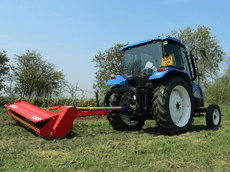CFE: Ambitious farming campaign must not fail

The long-awaited launch of the Campaign for the Farmed Environment is the best chance farmers have of fending off a compulsory replacement set-aside in England. But regulation will become a reality unless all farmers sign up to the initiative.
In the same way the much-feted Voluntary Initiative staved off the threat of a pesticide tax, the campaign is the industry-led approach to re-capturing the environmental benefits of set-aside. It was launched on Thursday (5 November).
The campaign aims to encourage and inspire farmers and land managers to adopt or continue management practices that increase or retain the environmental benefits provided by their farmland.
Land management practices that benefit the environment are being promoted along three key themes. These themes seek to increase farmland bird populations, enhance farm wildlife and protect resources such as soil and water.
To be successful, the campaign must meet ambitious targets agreed with the government. If targets are missed, onerous regulations could be imposed, forcing farmers to place a percentage of arable land under environmental management.
Over the next three years, farmers must double the area of key in-field options under entry-level stewardship (an extra 40,000ha), retain the area of uncropped land (179,000ha) and increase the area of voluntarily managed land by 30,000ha.
If the campaign fails, farmers will again face the prospect of being asked to take land out of production, abide by tighter cross-compliance regulations and face stiff penalties if they refuse to do so.
Industry leaders say this makes it important that as many producers as possible sign up to the campaign, recording their achievements in the process and going above and beyond the minimum requirements of ELS.
It sounds daunting. But it is achievable, not least because farmers are doing so much already. The campaign will bring together the many and confusing existing projects aimed at promoting environmental management under a single banner.
Some 22 counties are being targeted – mainly in East Anglia, the south-east and southern England. But all English farmers are being urged to play their part because if the campaign fails, all farmers will suffer the consequences of extra regulation.
Monitoring campaign progress will be kept to a minimum. Uncropped land is already recorded by DEFRA and Rural Payments Agency. And the amount of land in stewardship is already monitored by Natural England.
Details of voluntary measures will be recorded by farmers in a booklet to be sent out in January. This is likely to be accompanied by a postal survey, although not all farms will be asked to complete it. Only one in 400 farms is likely to receive a visit.
Working at a local level is seen as key. Local liaison groups are being set up in target counties to provide tailored advice and guidance to farmers and land managers depending on the environmental challenges and opportunities in their area.
Each county will have three or four liaison groups. A county chairman will oversee local farmers’ meetings held over the coming months to explain the campaign and encourage participation.
A network of beacon farms will be established across the country to demonstrate how the campaign will work in practice, as well as allowing other farmers and land managers to share ideas in backing the initiative.
Agronomists and other farm advisers are being trained to help farmers choose the options most suitable for their farms and local targets. Some 1500 agronomists will be asked to attend training events in the run-up to Christmas.
Farmers making cropping decisions this winter will be urged to do so while taking the campaign into account. So too will the thousands of growers expected to renew stewardship agreements in 2010.
The trick will be to encourage continued participation in stewardship, promote the selection of more effective options along the campaign’s three main themes and persuade more farmers to take them up.
Farmland birds in particular will benefit from revisions to stewardship options, including an extension to the hedgerow “no-cutting” period by a month and increasing the size of areas sown with wild bird seed mixture.
In addition, DEFRA scientists are developing a new option for “summer fallow”, which would be beneficial to ground nesting birds and provide farmland species with important summer feeding habitats.
